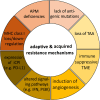Tumor-induced escape mechanisms and their association with resistance to checkpoint inhibitor therapy
- PMID: 31375885
- PMCID: PMC11028168
- DOI: 10.1007/s00262-019-02373-1
Tumor-induced escape mechanisms and their association with resistance to checkpoint inhibitor therapy
Abstract
Immunotherapy aims to activate the immune system to fight cancer in a very specific and targeted manner. Despite the success of different immunotherapeutic strategies, in particular antibodies directed against checkpoints as well as adoptive T-cell therapy, the response of patients is limited in different types of cancers. This attributes to escape of the tumor from immune surveillance and development of acquired resistances during therapy. In this review, the different evasion and resistance mechanisms that limit the efficacy of immunotherapies targeting tumor-associated antigens presented by major histocompatibility complex molecules on the surface of the malignant cells are summarized. Overcoming these escape mechanisms is a great challenge, but might lead to a better clinical outcome of patients and is therefore currently a major focus of research.
Keywords: Immune escape; Immunotherapy; MHC; Resistance; TIMO XIV; Tumor.
Conflict of interest statement
The authors declare that they have no conflict of interest.
Figures


References
-
- Leone P, et al. MHC class I antigen processing and presenting machinery: organization, function, and defects in tumor cells. J Natl Cancer Inst. 2013;105(16):1172–1187. - PubMed
-
- Zanker D, Chen W. Standard and immunoproteasomes show similar peptide degradation specificities. Eur J Immunol. 2014;44(12):3500–3503. - PubMed
-
- Saveanu L, et al. Concerted peptide trimming by human ERAP1 and ERAP2 aminopeptidase complexes in the endoplasmic reticulum. Nat Immunol. 2005;6(7):689–697. - PubMed
-
- Norbury CC, Eisenlohr LC. Editorial overview: antigen processing. Curr Opin Immunol. 2016;40:5–6. - PubMed
-
- Mintern JD, Macri C, Villadangos JA. Modulation of antigen presentation by intracellular trafficking. Curr Opin Immunol. 2015;34:16–21. - PubMed
Publication types
MeSH terms
Substances
Grants and funding
LinkOut - more resources
Full Text Sources
Other Literature Sources
Research Materials

